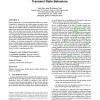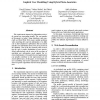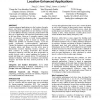1175 search results - page 35 / 235 » Modeling web applications reacting to user behaviors |
MOBIHOC
2010
ACM
13 years 6 months ago
2010
ACM
Recent popularization of personal hand-held mobile devices makes it important to characterize the mobility pattern of mobile device users, so as to accurately predict user mobilit...
CHI
2010
ACM
2010
ACM
Prefab: implementing advanced behaviors using pixel-based reverse engineering of interface structure
14 years 3 months ago
Current chasms between applications implemented with different user interface toolkits make it difficult to implement and explore potentially important interaction techniques in n...
HIS
2008
13 years 10 months ago
2008
The requirements imposed on information retrieval systems are increasing steadily. The vast number of documents in today's large databases and especially on World Wide Web ca...
CASCON
2006
13 years 10 months ago
2006
UML activity models (activities, for short) have become widely accepted for specifying the dynamic behavior of use cases. For an adequate specification of use cases in the context...
UIST
2004
ACM
14 years 1 months ago
2004
ACM
Location-enhanced applications use the location of people, places, and things to augment or streamline interaction. Location-enhanced applications are just starting to emerge in s...



